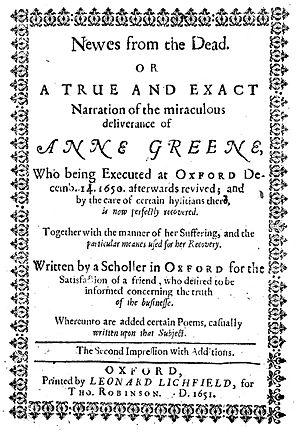Anne Greene facts for kids
Anne Green was an English woman who lived in the 1600s. She became famous for a truly amazing reason: she survived being hanged! Doctors from the University of Oxford helped bring her back to life after her execution. Her story was seen as a miracle by many people at the time.
Contents
Anne Green's Early Life
Anne Green was born around 1628 in a place called Steeple Barton in Oxfordshire, England. When she was a young adult, she worked as a scullery maid. A scullery maid was a servant who helped with cleaning and kitchen tasks. Anne worked in the home of Sir Thomas Read, who was an important judge in the area. His home was in a nearby village called Duns Tew.
Trial and Unjust Punishment
Anne faced a very serious problem. She became pregnant, but she later said she did not know she was pregnant until she gave birth to a very tiny baby prematurely. Sir Thomas Read, her employer, accused Anne of hiding the birth of her baby. At that time, there was a law that said if a woman hid the death of her baby born outside of marriage, it was assumed she had murdered it.
During her trial, a midwife (a person who helps with childbirth) said that the baby was too small to have ever been alive. Other servants also said Anne had been unwell before the birth. Despite this, Anne Green was found guilty of murder. She was sentenced to be hanged at Oxford Castle on December 14, 1650. Anne even asked her friends to pull on her body and a soldier to hit her to make her death quicker. After about half an hour, everyone thought she was dead. She was then taken down and given to two doctors from the University of Oxford, William Petty and Thomas Willis, for study.
Her Amazing Recovery
The very next day, the doctors opened Anne Green's coffin. To their surprise, they found that she still had a faint pulse and was breathing weakly! Doctors Petty and Willis quickly called for help from their colleagues, Ralph Bathurst and Henry Clerke. The doctors worked together to save her. They placed Anne in a warm bed with another woman, who rubbed her to keep her warm.
Anne began to get better very quickly. She started speaking after about 12 to 14 hours of treatment. After just four days, she was able to eat solid food. Within one month, she had fully recovered. The only thing she couldn't remember was what happened around the time of her execution.
Pardon and Later Life
While Anne was recovering, the authorities decided to delay her execution. In the end, they gave her a full pardon, meaning she was officially forgiven and set free. Many people believed that God had saved her, showing that she was innocent. One writer even noted that Sir Thomas Read, who had accused her, died just three days after Anne's execution. This meant there was no one to argue against her pardon.
However, not everyone was happy about her survival. Another writer mentioned that some of her enemies were very angry. They wanted her to be hanged again, even though it was against the law. But some honest soldiers stepped in and protected Anne, stopping this from happening.
After her recovery, Anne Green went to live with friends in the countryside. She even took the coffin she was placed in with her! She later got married and had three children. Anne Green passed away in 1659.
How Anne's Story Became Famous
Anne Green's incredible story inspired several writings in the 1600s. One of the first was a pamphlet called A Wonder of Wonders by W. Burdet, published in 1651. This pamphlet described her survival as a miracle.
In the same year, Richard Watkins also published a pamphlet called Newes from the Dead. This one gave a more factual, medical account of what happened. It also included 25 poems about the event, written in different languages. One of these poems was by Christopher Wren, who later became a very famous architect. He designed St. Paul's Cathedral in London!
Anne Green's story was also mentioned in other important books. It appeared in the 1659 English version of The History of the World by Denis Pétau. It was also in Robert Plot's 1677 book, The Natural History of Oxfordshire. Plot's book was the first to mention that Anne later married and had children, and the year she died.


